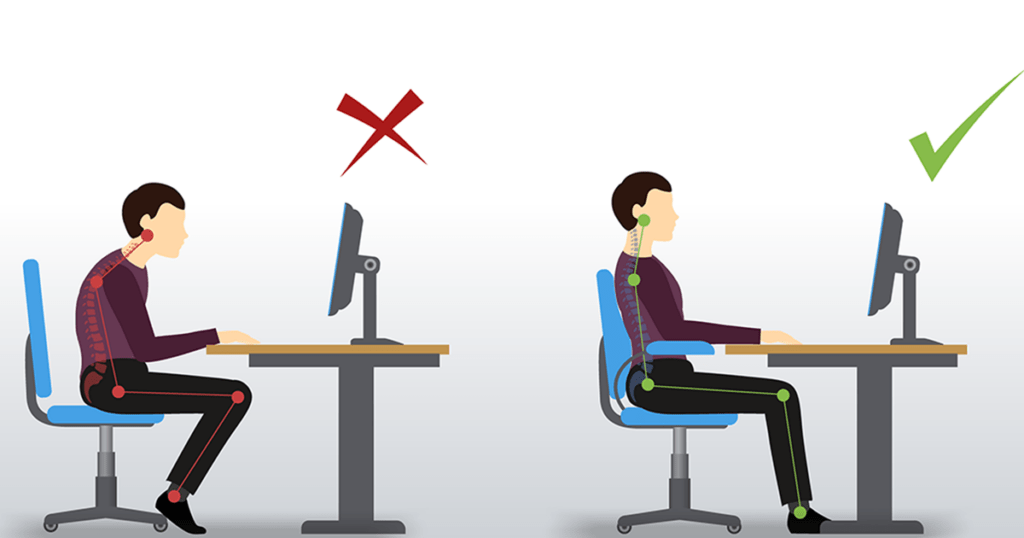
Ergonomic also has its hazards. Poor ergonomic may lead to many health issues. Reading this article of FittingChairs to find out what is ergonomic hazard and how to prevent your workspace from them.
What is ergonomic hazard?
When it comes to ergonomic, it is important to know what is ergonomic hazard. An ergonomic hazard is any factor in the workplace that may cause injury or health issues, such as musculoskeletal injuries.
There are many different kinds of ergonomic hazards you may encounter in the workplace, such as task chairs that are unsupportive or ill-suited to the individual employee.
Other hazards might include a poorly designed workstation, monitor height that is unsuitable for the employee, or technology that is not ergonomically designed or placed correctly.
Aside from that, some ergonomic hazards can also be factors you may not typically pay attention for, such as lighting that is too bright or noisy equipment.
Sendetary while working for long periods can also be an ergonomic hazard to employees, as this can increase the risk of issues such as back pain and stiff muscles.

Types of ergonomic hazards
So what is ergonomic hazard type? Objects, environments and systems are the three main types of ergonomic hazards that can result in poor posture or uncomfortable working conditions.
The main areas of concern for ergonomic hazards include:
- Equipment layout and operation
- Lifting, pushing and pulling (manual handling)
- Lighting
- Noise
- Systems and computer programs
- Task, job and workplace design
- Workstation design and height
How to know if something is an ergonomic hazard?
What is ergonomic hazard? How to know if something is an ergonomic hazard?
The severity of ergonomic hazards depends on the level of exposure over time. Injuries sustained from these hazards can include anything from sore muscles to long-term illnesses.

Ergonomic hazards include:
- Improperly adjusted workstations and chairs
- Frequent lifting
- Poor posture
- Awkward movements, especially if they are repetitive
- Using too much force, especially if it’s done frequently
- Vibration
Ergonomic hazards are mainly a result of the way a space is designed. Therefore, planning ahead and thinking about how employees interact with their workspace is crucial.
Ergonomic hazards effects
It’s important to understand that ergonomics isn’t just about comfort. It’s directly linked to safety and injury prevention.
Poor ergonomics contribute to muscle strain, muscle imbalances, and fatigue.
These hazards can also result in carpal tunnel syndrome, tendonitis, sprains and other debilitating injuries.
Many muscle strains result from performing the same motion over and over again. These are some of the most common workplace injuries.
Ergonomics alone won’t eliminate this type of injury. However, proper ergonomics will significantly reduce fatigue and strain.
Several common work activities pose repetitive stress ergonomic hazards. Examples include typing and mousing, which can result in carpal tunnel syndrome.

Ergonomic hazard prevention
Simple solutions often work best. Here are some simple tips for ergonomic hazard prevention:
- Adjust the height of working surfaces to reduce long reaches and awkward postures.
- Put work supplies and equipment within comfortable reach.
- Provide the right tool handle for the worker.
- Vary tasks for workers.
- Encourage short rest breaks.
- Reduce the weight and size of items workers must lift.
- Provide mechanical lifting equipment.
- Replace telephone handsets with headsets anywhere they are used frequently.
- Provide ergonomic chairs and stools.
- Supply anti-fatigue floor mats.
- Reduce or eliminate vibrations and sharp edges.

And here is how to start to prevent ergonomic hazards in work place for employers. Remember to eliminate a mismatch between the physical requirements of the job and the physical capacity of the worker.
- Examine injury and illness records to determine which jobs have a history of ergonomic problems.
- Use employee comments and recommendations to help formulate solutions to the ergonomic problems you discover.
- Establish policies encouraging use of equipment for heavy or repetitive lifting.
- Implement programs to educate employees and managers about ergonomic techniques designed to prevent and correct musculoskeletal disorders (MSDs).
- Develop an evaluation program to ensure that improvements are constantly made.
See more:
Hopefully, this article of FittingChairs about what is ergonomic hazard can help you know more about the causes lead to this and get the solution for how to prevent them at work.






